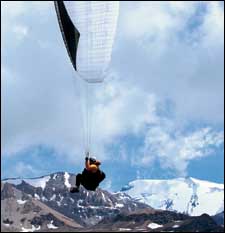THERE’S A BASIC RULE in paragliding: Don’t fly over anything you wouldn’t want to land on. Makes sense, given that pilots are at the mercy of weather conditions that can change without warning. But the upshot is that a lot of the most exciting terrain is effectively off limits. One such place is the northern Andes of Chile and Argentina, a jagged landscape dominated by tight canyons, toothy peaks, and violent winds.

That upshot changed this winter, when Canadian adventurer Will Gadd, 37, and top aerobatic competitor Chris Santacroce, 31, of Salt Lake City, completed a daring first crossing of the range, launching their paragliders, on a rare calm evening, from the top of the Chilean ski resort of Portillo, at 13,900 feet, and flying east along the twisting Trans-Andean Highway to a field near the base of 22,834-foot Aconcagua, in Argentina. The two-hour, 15-mile flight saw the duo soaring up to 15,000 feet on thermals and updrafts as they corkscrewed around glaciated mountains where any mishap could have been fatal.
“A minor mistake and we could easily have been thrown into a cliff at 35 miles an hour,” says Gadd. “Even if you survived the impact, chances are you’d die waiting for a rescue.”
Gadd, a top climber who makes a living getting sponsorship for his exploratory stunts, first thought of crossing the Andes while scaling Aconcagua back in 1993. He secured funding from Red Bull and convinced Santacroce and a third pilot, 29-year-old Salt Laker Othar Lawrence, to sign on. (Lawrence would drop out after ten days in the Andes.) The team arrived in Chile on December 6 and started scouting routes by foot and chartered plane. Gadd and Santacroce’s December 17 flight was actually planned only as a quick test run above Portillo, but once in the air, they realized they’d caught an ideal weather window.
What’s next for Gadd? Not the Andes again anytime soon. “I’ve spent nights thinking, I really need to go back there,” he says. “But then I think, No way.”


